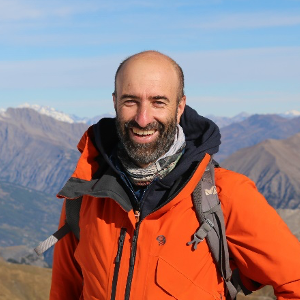Mighty mountains on today’s route and during the many helicopter shots that we will – weather permitting – get to see. The Alps are a very photogenic part of France. Like a living being, the mountains react in different ways to climatic conditions. Let’s take a look at the mighty mountains and be in awe of its beauty. However, never forget the dangers that come with it.
We start at an altitude of 4,000 meters where the peloton will never arrive. Above 4,000 meters it is so cold that the ground is frozen deep and does not ever thaw. The mountain is frozen and the blocks are as if cemented by the ice. On the surface, snow accumulates and falls in avalanches or feeds large glaciers. These flow gradually towards the valleys or collapse abruptly during serac falls. Seracs are blocks or columns of glacial ice, often formed by intersecting crevasses on a glacier. We see these risks in the area comprising the summit of Mont Blanc and neighboring peaks.

Going down
Between 4,000 and 3,000 meters the ground temperature over the entire year is on average below zero Celsius. This defines permafrost. Seasonal temperature variations warm the ground or surface walls during the summer season. The permafrost then thaws over several meters. It creates an active layer in its upper part. This seasonal succession is superimposed on daily fluctuations, with a nocturnal refreeze. Under the effect of these temperature changes, the ice melts and then refreezes. This process promotes rock falls.
Current global warming amplifies this process by increasing the thickness of the active layer that is subjected to this succession of temperature changes. Also a greater number of blocks, some of up to 300,000 m3, collapse during heat waves. This development occurs in a large part of the Mont-Blanc massif. In 2005 a collapse of a pillar with a volume of ~300,000 m3 destroyed the Bonatti route, one of the emblematic climbing routes in the Alps.

When disaster strikes
Below 3,000 meters the temperature at ground level remains above zero. The temperature has less influence on the stability of the ground and the rock walls. It is the precipitation that mainly controls the gravity hazard. During intense rains, the water seeps into the cracks and causes an increase in pressure on the surrounding rock. This enhances the possibility of falling blocks but can also lead to the collapse of entire walls. The mobilized volumes then exceed ten million m3 and these collapses spread rapidly in the valleys and give rise to mudslides.
In the spring of 1471, a collapse of the Dérochoir wall above Passy and Le Fayet started from the ridge at an altitude of 2010m. It reached the Gorges de l’Arve at an altitude of less than 800 m. It resulted in the formation of a natural dam and the creation of a lake. In 1970 again, a collapse, however much smaller, induced another landslide which devastated a sanatorium and killed 71 people.

Clues that show a weakening of rock masses are found throughout the Alps. Such a weakening does not necessarily lead to catastrophic events. Crevasses have been opening for more than a thousand years in the gneiss located on the slope dominating the Col des Montets. They are several tens of meters deep and are at the origin of collapses including blocks of more than 1000 m3. Their trajectories have nevertheless been deviated by a secondary ridge which thus constitutes a natural protection of the valley.
Mighty mountains, might risks
Gravity risks regularly obstruct traffic routes. For example, in 2013, the access road to the Mont-Blanc tunnel was again cut off for several hours following debris flow. Or more recently in 2019 when a stage of the Tour de France to Tignes was stopped due to landslides and mudslides which occurred following a very intense storm. The stage was stopped by the race organization and commissaires. The time gaps on the Col de l’Iseran were taken. That’s where Julian Alaphilippe lost his yellow jersey to Egan Bernal. The Colombian would go on and win the race that year.

The mountains have always been a sensitive environment regularly affected by gravitational hazards. These occur more particularly in certain areas while others are protected by the configuration of the relief and by the geological conditions.
A mapping of the distribution of these risk areas has already been carried out in the Alps. It is based in particular on the consideration of past experiences. Studies and continuous observation systems on the most sensitive sectors are currently being implemented by scientists and public authorities in order to understand and above all to better estimate these risks.It is essential to take these studies into account in order to envisage a sustainable development of the Alpine valleys and thus organize daily life in these areas where climate change amplifies the risk.
-

My objective is to understand the tectonic-relief-erosion interactions during the quaternary climatic cycles; indeed the quaternary is characterized by an increase in erosion. The question is to understand how a mountain range reacts to such an increase, both in terms of localization of movement along faults in the upper crust and in terms of of uprising? For this it is also necessary to understand where the erosion is particularly increasing in a chain and what are the dominant erosive processes during the glaciation-deglaciation cycles.
-

The common denominator of my research activity is the understanding of geomorphology as a result of the interactions between tectonic and climatic processes. My current research aims in particular to quantify the impact of glacier retreat on seismicity and the behavior of active faults. Tierra del Fuego (southern Patagonia) and the Western Alps are my favorite places to understand these phenomena.
-

-







